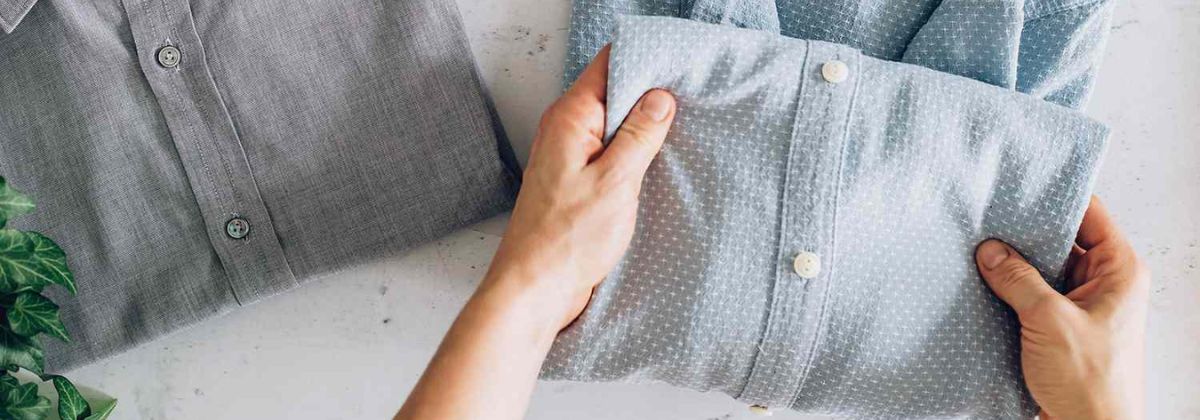08 Aug The Art of Folding Clothes: Mastering Neat and Organized Laundry
In the realm of household chores, there exists an often overlooked yet essential skill: the art of folding clothes. While folding laundry might seem mundane, mastering this skill can bring a sense of order and serenity to your living space. In this blog post, we will delve into the intricacies of achieving perfectly neat and organized laundry. We also want to transform your laundry-folding routine into a satisfying and efficient endeavour.
Why is Folding Clothes Important?
folding clothes is important for several reasons:
- Prevents Wrinkles: Folding clothes is a proper way helps prevent wrinkles in your clothes. Neatly folded clothes are less likely to develop deep creases. This can be challenging to remove and might require ironing.
- Maximizes Space: Folding clothes efficiently allows you to maximize storage space in drawers, closets, and shelves. Well-folded items can be stacked or arranged in a way that optimizes the use of available space.
- Maintains Clothing Shape: Folding clothes preserves their original shape and structure. Hanging certain garments for extended periods can lead to stretching or misshaping. Folding maintains the integrity of the fabric.
- Easy Accessibility: Neatly folded clothes are easier to access and identify. You can quickly find the item you need without rummaging through a messy pile of clothes.
- Organizational Benefits: Proper folding contributes to an organized living space. When your clothes are neatly folded and arranged, it’s easier to keep track of your wardrobe and make thoughtful outfit choices.
- Care and Longevity: Folding clothes demonstrate care for your belongings. It can prolong the lifespan of your garments. Proper storage minimizes friction and stress on fabrics, reducing wear and tear.
- Travel-Friendly: Folded clothes are often more travel-friendly than hanging items. They can be packed efficiently in suitcases, reducing the chances of wrinkles during transit.
While folding is essential for maintaining clothes, it’s worth noting that different fabrics and clothing types may require specific folding techniques. Delicate items, such as silk blouses or knitwear, may need extra care to prevent damage. Additionally, some clothes are better suited for hanging, like dresses or suits; hanging helps to maintain their shape. Ultimately, a combination of proper folding and hanging based on clothing type will help you keep your wardrobe in excellent condition.
The Art of Folding Clothes
- Sort Before You Fold: Before embarking on the folding journey, ensure that your laundry is sorted according to fabric type, colour, and size. This step will make the folding process more streamlined and prevent wrinkles from forming during storage.
- Gather the Right Tools: Equip yourself with the necessary tools, such as a flat surface or folding board, hangers, and clips. These aids will assist you in achieving uniform folds and maintaining the crispness of your clothing.
- Master the Basics: Start with the fundamental folding clothes techniques, such as the square fold and the rectangle fold. These methods work well for t-shirts, shorts, and other everyday garments. Maintain even edges and symmetrical creases to create a polished appearance.
- Delve into Specialized Folds: Different garments require specific folding techniques. For dress shirts, use the military-style fold to preserve collars and maintain a professional look. Utilize the Marie Kondo method for underwear and socks, creating compact and organized bundles.
- Embrace the KonMari Philosophy: Marie Kondo’s philosophy of only keeping items that “spark joy” extends to folding. When folding, take a moment to appreciate each piece of clothing, and fold it with care. This practice results in neat storage and fosters a deeper connection with your belongings.
- Towels and Linens: Fold towels into thirds lengthwise and then in half to create a compact, stackable form. For fitted sheets, fold the corners to create a rectangle before folding them into thirds. This technique maintains a consistent shape and makes linens easier to store.
- Time-Saving Techniques: If you’re short on time, consider the “rolling” technique for casual wear like jeans and t-shirts. Rolling garments not only saves space but also minimizes wrinkles.
- Hang Strategically: Some items, such as delicate blouses, dresses, and pants, are better suited for hangers. Use quality hangers to maintain the shape of your clothing and prevent unsightly bumps.
- Create an Organized Storage System: Neatly folded laundry is only as effective as its storage. Invest in storage solutions like drawer dividers, shelf organizers, and clear containers to keep your folded items easily accessible and visible.
- Regular Maintenance: To sustain your perfectly folded and organized laundry, commit to regular maintenance. Folding clothes and putting away clean laundry promptly van help to prevent wrinkles and clutter from accumulating.
Folding or Hanging? Which is Better?
Whether you should fold or hang your clothes depends on the type of clothing, your available storage space, and your personal preferences. Here’s a general guideline to help you decide:
Fold Clothes:
- T-shirts, Jeans, Casual Wear: You can efficiently fold everyday items like t-shirts, jeans, sweatshirts, and casual wear. This saves space and prevents wrinkles, making them easy to store in drawers or on shelves.
- Underwear and Socks: Folding underwear and socks, especially using methods like the Marie Kondo technique, can help you keep them organized and easily accessible.
- Knits and Delicates: Delicate fabrics like knitwear or silk items are better off folded to prevent stretching or distortion on hangers.
- Pyjamas and Loungewear: Folding clothes like these items can help to improve storage, especially if they’re not prone to wrinkling.
Hang Clothes:
- Dresses and Formal Attire: Dresses, suits, blouses, and other formal wear maintain their shape better when hung. This prevents creasing and ensures they’re ready to wear without needing ironing.
- Button-Down Shirts: Hanging shirts with buttons fastened helps maintain their collars and keeps them wrinkle-free.
- Jackets and Outerwear: To maintain the shape and structure of coats, jackets, and blazers, it is better to hang them.
- Items Prone to Wrinkles: If you have fabrics that wrinkle easily and you want to avoid ironing, hanging might be a better option to keep them smooth.
- Visibility: Hanging clothes can make it easier to see your options and plan outfits, which can be particularly useful for workwear or formal occasions.
The art of folding clothes is more than just a household chore; it’s a practice that brings harmony and order to your living space. By following these techniques and embracing the philosophy of mindful folding, you can transform a mundane task into a gratifying ritual that enhances your environment and your daily life. Say goodbye to crumpled clothing and hello to the joy of perfectly neat and organized laundry.




Sorry, the comment form is closed at this time.